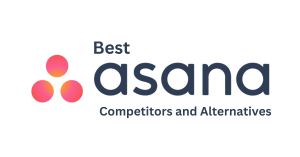Ah, meetings—the bane of every office worker’s existence. But let’s be real—they’re not going anywhere. So, if we can’t eliminate them, we might as well try to make them as painless as possible. Enter meeting management software.
These handy tools can help turn your mind-numbing, never-ending meetings into streamlined, productive power hours.
Lucky for you, we’ve scoured the internet to bring you a list of the 11 best meeting management software options.
So grab a coffee (or a drink, depending on the time of day), and let’s start this meeting on the right foot.
What is the best meeting management software?
Here are our best picks of the top meeting management platforms to help you streamline your meetings.
1. Calendly.
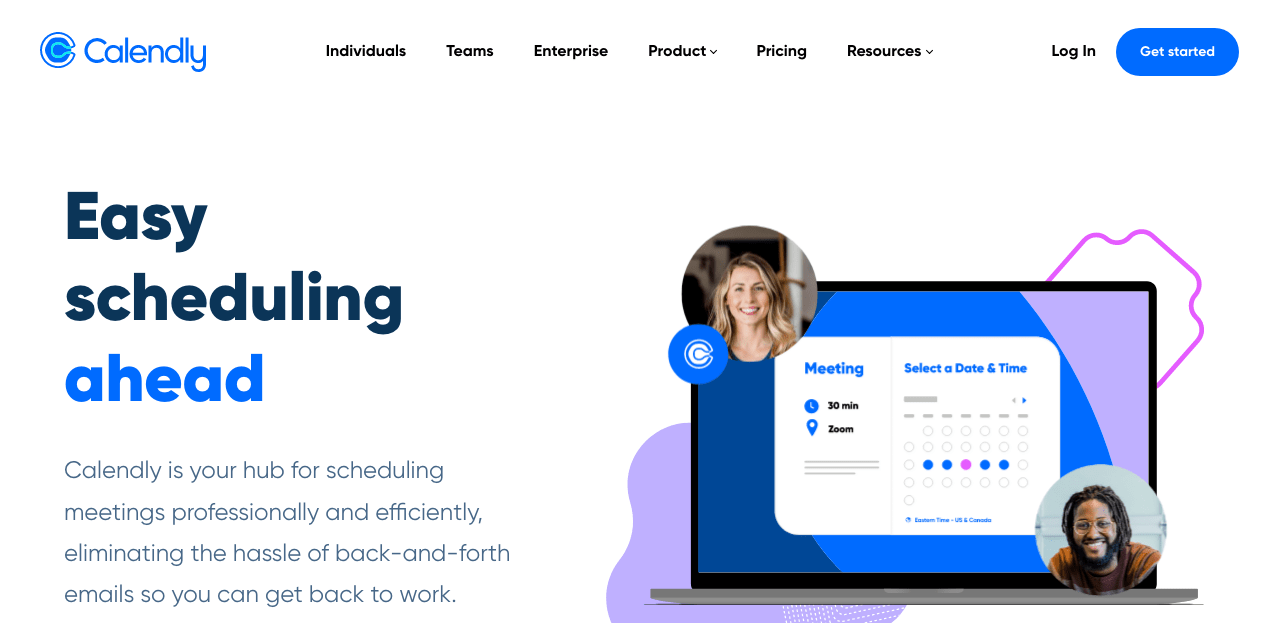
Calendly is a revolutionary scheduling automation platform that helps professionals and businesses easily schedule meetings. It offers a wide range of integrations, including Zoom, Salesforce, Google, Microsoft, Slack, and Zapier, making it highly customizable and suitable for teams of all sizes.
One of Calendly’s standout features is its enterprise-grade security and compliance, making it ideal for businesses of all types.
It’s easy to use and learn. You can email, text, or add your Calendly availability to your website, allowing you to book high-value meetings in seconds and turn scheduling into a competitive advantage.
In addition to its scheduling capabilities, Calendly offers customization options for reminders and follow-up workflows to keep deals moving and help you focus on selling. It also allows you to manage how your coworkers create meeting types, send consistent reminders, and adhere to brand standards.
Key features of Calendly.
- Automatic assignment: When creating a meeting, Calendly automatically assigns it to the appropriate host.
- Instant connections: Calendly can be integrated with the tools you use every day through integrations with Zoom, Salesforce, Google, Microsoft, Slack, Zapier, and more.
- Alerts and notifications: Receive meeting reminders and notifications so you never miss a meeting.
- Event management: Schedule, reschedule, or cancel meeting events easily.
- Appointment Scheduling: Schedule appointments with clients, customers, or patients from your Calendly account.
- Time zone detection: Calendly automatically detects and adjusts for time zones so that you can easily schedule meetings.
- Multiple calendar integration: Connect Calendly to various calendars to organise your meeting schedule.
- Collaboration tools: With features like meeting notes and recordings, you can collaborate with team members before, during, and after meetings.
Calendar pricing:
Calendly offers free and 3 premium plans with a 14-day free trial; no credit card is required. These are the plans Calendly offers:
- Basic: free.
- Premium: $8 per user per month (billed annually), or $10 per user, per month (billed monthly).
- Pro: $12 per user per month (billed annually), or $15 per user, per month (billed monthly).
- Enterprise: Contact the Calendly sales team for a quote.
2. ClickUp.
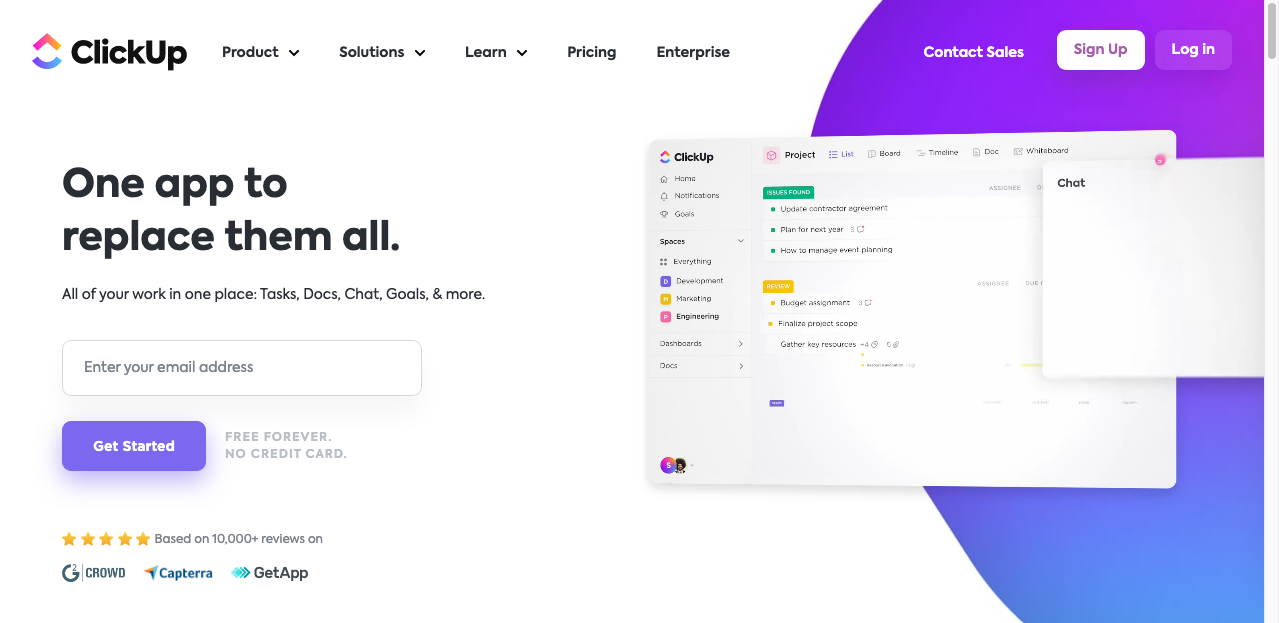
If you’re searching for comprehensive meeting management software that allows teams to collaborate and work more efficiently by centralizing all their work in one place, try ClickUp.
With features like Docs, Reminders, Goals, Calendars, Chat, Scheduling, Assigned Comments, Custom Views, and more, ClickUp makes it easy for teams of all sizes to deliver work more efficiently and boost productivity.
My standout feature of ClickUp is its real-time chat function, which allows you to tag individuals or groups, assign comments for action items and link tasks to get more done together.
You can create chat channels for specific teams or projects and control who can access each chat. With millions of users and over 200,000 teams at companies like Samsung, IBM, Twitter, Uber, and Ubisoft, ClickUp is quickly becoming the go-to-meeting management software for businesses of all sizes.
In addition to its chat function, ClickUp allows you to embed webpages, spreadsheets, videos, and more for easy access alongside conversations and see all links and attachments conveniently grouped for quick reference.
Key features of ClickUp.
- Workflow automation: With features like task dependencies, due dates, and notifications, you can easily manage and track work progress and ensure that work is always on track.
- Assignment creation and management: Assign tasks to team members, set meeting agendas, and create meeting minutes.
- Activity feed: See what’s happening in real-time so you’re always updated on the latest changes.
- Progress tracking: Track work progress with features like burndown charts, task lists, and Kanban boards.
- Task prioritization: Prioritize tasks with features like labels, custom views, and task dependencies.
- Team collaboration: Work more effectively with features like team chat, mentions, and comments.
- Approval process control: Manage the approval process with features like approvals, signoffs, and document management.
- Support for agile methodology: ClickUp offers features such as sprints, backlogs, and Kanban boards to support agile methodology.
ClickUp pricing.
Free: $0 free forever with features like:
- 100MB storage
- Unlimited Tasks
- Unlimited Users
Unlimited: $5 a user per month billed annually or $9 per user/ month billed monthly with:
- Unlimited Storage
- Unlimited Views
- Unlimited Integrations
- Unlimited Reporting
- Guests and Permissions
- Goals – Portfolios
- Custom Fields
- Send and receive emails
- 1,000 Automations/month
- View today’s activity on Pulse (live overview)
Business: $9 user/month billed annually, or $19 user/month billed monthly with:
- All Features of Unlimited Plus,
- Custom Exporting
- Unlimited Teams
- Advanced Public Sharing and 24/7 Support
Enterprise: Contact the team for pricing.
- The Enterprise team is for large teams with all the business, plan features, and more.
3. Slack.
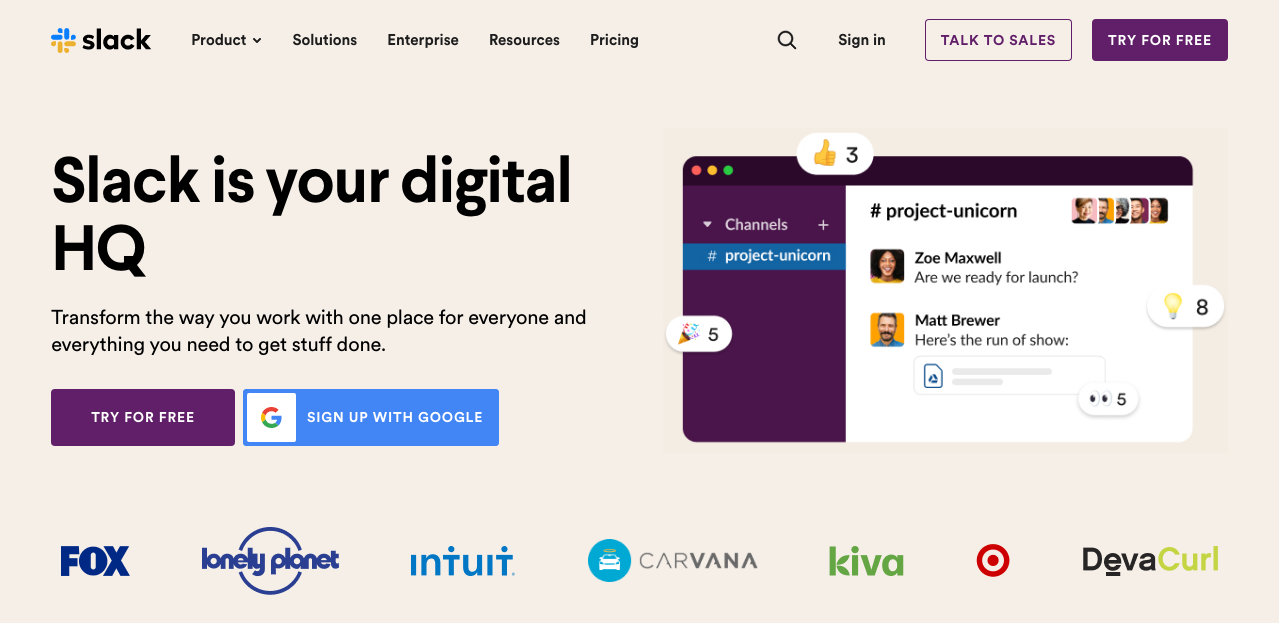
Slack is a powerful team collaboration and messaging platform that simplifies communication and helps teams work more efficiently.
Whether you’re struggling to track a large team’s meeting minutes or just looking for a better way to communicate, Slack has you covered.
The platform is free, with paid plans offering additional features and greater controls. It provides real-time messaging through calls and chats, a searchable record of all your files and conversations, and integrations with popular tools such as MailChimp, Dropbox, and Google.
The standout feature of Slack is its ability to organize conversations into public channels that anyone on your team can join and private channels for more sensitive discussions.
It also offers direct messaging for one-on-one conversations, making it easy to chat, send audio and video clips, or hop on a huddle to talk things out live.
In addition to its messaging capabilities, Slack offers powerful tools like Workflow Builder, which allow you to automate routine tasks and streamline your workflows.
Key features of Slack.
- Chat and messaging: Provides instant messaging, and you can easily search for specific messages, conversations, or files.
- Visual planning tools: A drag-and-drop interface makes it easy to plan projects and track tasks visually.
- Audio and video conferencing: You can make audio and video calls directly from Slack.
- Commenting and notes: You can leave comments or notes on specific messages, files, or tasks.
- Internal knowledge base: A searchable database of all your team’s knowledge and conversations.
- File sharing and management: Let you easily share files and track who can access them.
- Web and mobile application: Slack is accessible from any web browser or mobile device.
- Call recording: Records audio and video calls for easy reference later.
Slack pricing:
Slack is available across three premium tiers with pricing based on per user per month, outlined below:
- Free: $0 for teams wanting to try out slack
- Standard plan: $6.67/user/month (billed annually) or $8.00a user per month (billed monthly)
- Plus plan: $12.50a user per month (billed annually) or $15.00/user/month (billed monthly)
- Enterprise Grid: contact Slack for custom pricing details
4. Zoho meeting.

Zoho Meeting is a comprehensive online meeting management software that allows you to host and conduct secure online meetings, conferences, and webinars. It’s web-based, so all you need is an internet connection to use it, and it offers a free trial so you can try it out before committing to it.
One of the standout features of Zoho Meeting is its deep integration with Zoho’s ecosystem and other major third-party services, making it a convenient and seamless choice for businesses.
It’s particularly useful for sales and marketing meetings, as it allows moderators to control the discussion and add context by sharing documents and presentations through interactive screen sharing.
In addition to its meeting capabilities, Zoho Meeting offers multiple security features, such as lock meetings, organization-level video settings, and entry/exit notifications to safeguard your meetings.
It also allows you to record, replay, and share your web meeting recordings with members who couldn’t attend. The Zoho Meeting iOS and Android apps allow you to join meetings and webinars from your mobile devices.
Key features of Zoho meeting.
- Meeting management: You can create meeting agendas, assign tasks, and take minutes. And you can track the progress of your meetings with ease.
- Attendee management: You can add and remove attendees from your meetings, view their contact information, and view their meeting history.
- Low bandwidth requirements: Zoho Meeting uses low bandwidth, so it can be used even with a slow internet connection.
- Available for Windows, OS, and mobile: Use Zoho Meeting with an internet connection on any device.
- Screen sharing: Share your screen with other meeting participants so they can see what you’re working on.
- QuickMeet service: Schedule and start meetings in seconds with QuickMeet.
- Participant roles and permissions: Assign moderator, presenter, and attendee roles to meet participants and set permissions to control who can do what in your meetings.
- Electronic hand raising: Raise your hand electronically to let the meeting moderator know you want to speak.
Zoho meeting pricing.
Zoho Meeting offers a free version with limited features for up to 100 participants and webinar attendees and a 14-day free trial for the paid plans, which are fully functional and have all the features of the professional edition. Their subscription plans are based on the number of participants or attendees per session and the number of hosts/organizers.
- Meeting-10 Participants – $3/month/host
- Meeting-25 Participants – $6/month/host
- Meeting-50 Participants – $9/month/host
- Meeting-100 Participants – $12/month/host
5. Webex.
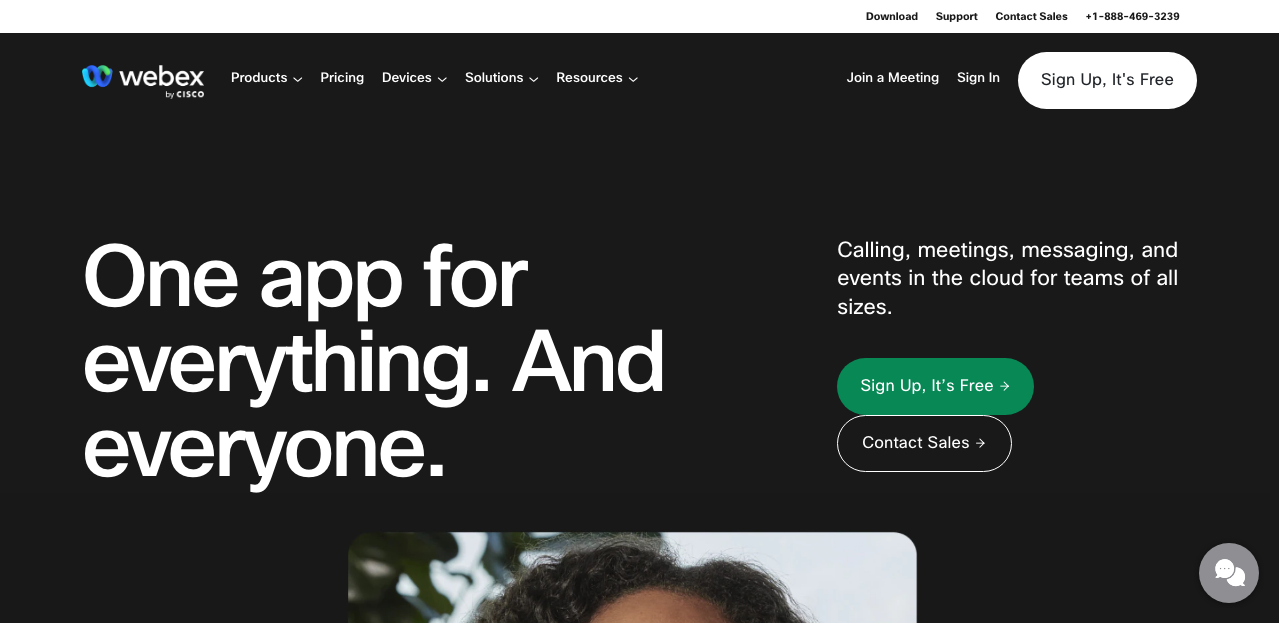
Webex Events is a video conferencing, cloud Calling, and Screen Sharing software that offers an inclusive, engaging, and interactive experience for virtual, hybrid, and in-person events. It supports seamless collaboration across devices, locations, and organizations, making it ideal for teams of all sizes.
With Webex Events, you can create a more efficient workflow with team messaging and file sharing for internal and external teams, all in the same space.
It also offers easy interactive audience tools for polling and Q&A, encouraging more active participation in meetings and events.
One of Webex Events’ standout features is its ability to host virtual events with up to 100,000 attendees, making it suitable for even the largest events.
In addition, It offers end-to-end event management, supporting immersive, intuitive, and inclusive virtual, hybrid, and in-person events.
Key features of Webex.
- Virtual Event Suite: A comprehensive solution that helps you plan, promote, and deliver successful virtual, hybrid, and in-person events.
- Automatic Transcription: Webex automatically transcribes your meeting so you can focus on the discussion, not taking notes.
- Audience Engagement: With features like Q&A, Polling, and Hand Raise, you can keep your audience engaged and involved in the discussion.
- Action Item Tracking: Webex can track action items from your meeting so nothing falls through the cracks.
- Live Preview Tools: Webex’s live preview tools let you see how your meeting will look to participants.
- Scheduling: Schedule your meeting in advance or start it with the touch of a button.
- Audience Analytics: Get insights into who is attending your conference, how engaged they are, and what questions they’re asking.
- Communities: Join or create a community in Webex to connect with like-minded people and collaborate on projects.
Webex pricing.
Webex offers a free plan and 3 premium pricing tiers, namely:
- Basic plan: $0 monthly – HD meetings with up to 100 people.
- Meet plan: $13.50 per month – Premium meeting features HD meetings with up to 200 people.
- Call plan: $ 17 per user per month – Premium meeting features HD meetings with up to 100 people.
- Meet + Call Plan: $25 monthly – HD meetings with up to 200 people.
Related article: 9 Best PRM Tools For Businesses
6. GoToMeeting.
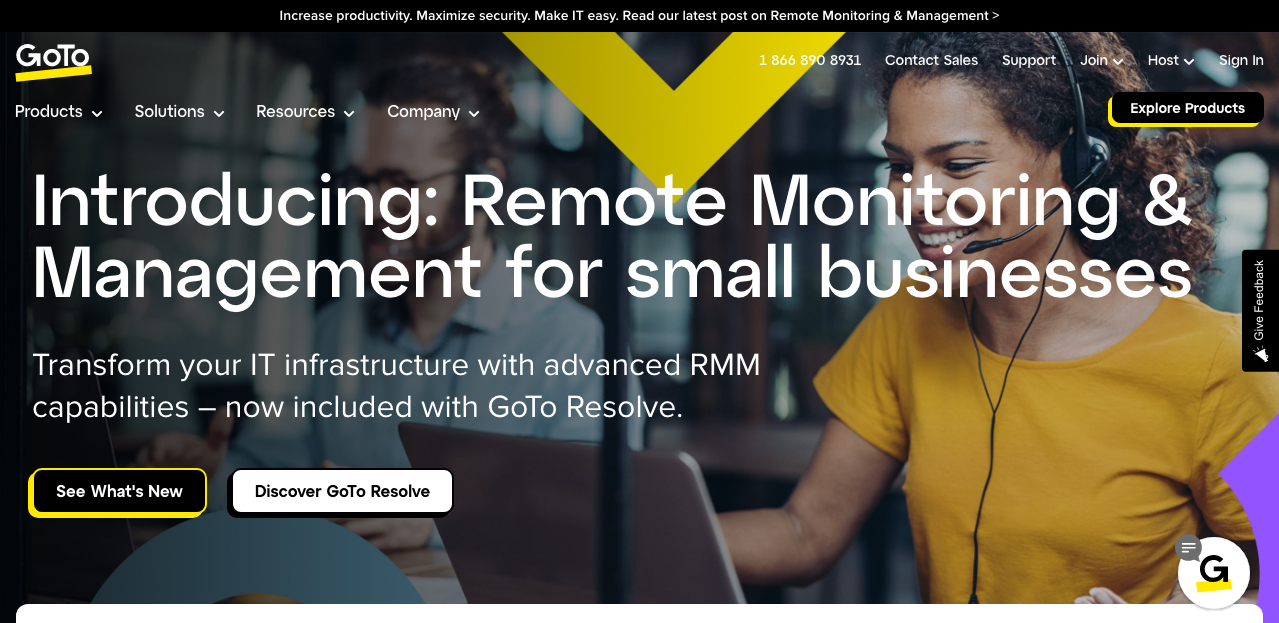
GoToMeeting is a trusted and professional conferencing software solution that makes meeting online with colleagues and customers easy and cost-effective.
It offers high-definition webcam sharing, making the meeting experience more engaging, and an excellent collaboration solution that allows employees to work effectively anytime, anywhere, on any device.
With millions of businesses trusting GoToMeeting for its reliability and professionalism, it’s easy to see why it’s a go-to choice for many companies. It’s an award-winning solution that works instantly on any device, allowing you to schedule and launch meetings in seconds without downloading any software.
GoToMeeting offers HD video meeting quality that feels like being in the same room without leaving your desk. You can join a meeting from any device with just one click, even if you’re on the go.
Whether you’re in the office or out of the office, GoToMeeting has you covered. It’s a powerful and reliable tool for conducting professional online meetings and collaborations.
Key features of GoToMeeting.
- Group live chat: Easily engage with participants personally with group live chat.
- Notifications blocker: Keep your meetings running smoothly by blocking notifications from popping up during your screen share.
- In-browser application: You don’t need to download any software; just launch the meeting in your browser, and you’re ready to go.
- User authentication: Ensure only authorized users can join your meeting by requiring a password.
- Audience polling: Get instant feedback from participants with in-meeting polls.
- Slideshows: Make your presentations more engaging with slideshows.
- Integrates with social media: Share your meeting to engage with a broader audience.
- Whiteboards: Brainstorm ideas and collaborate with participants in real time with whiteboards.
GoToMeeting Pricing.
Go to Meeting offers 3 main premium plans, all with a free trial, namely:
- Professional: $14/organizer/month, billed annually (150 participants)
- Business: $19/organizer/month, billed annually (250 participants)
- Enterprise: Contact LogMeIn for custom packages that fit your company’s needs. (Up to 3,000 participants)
7. Google Meet.
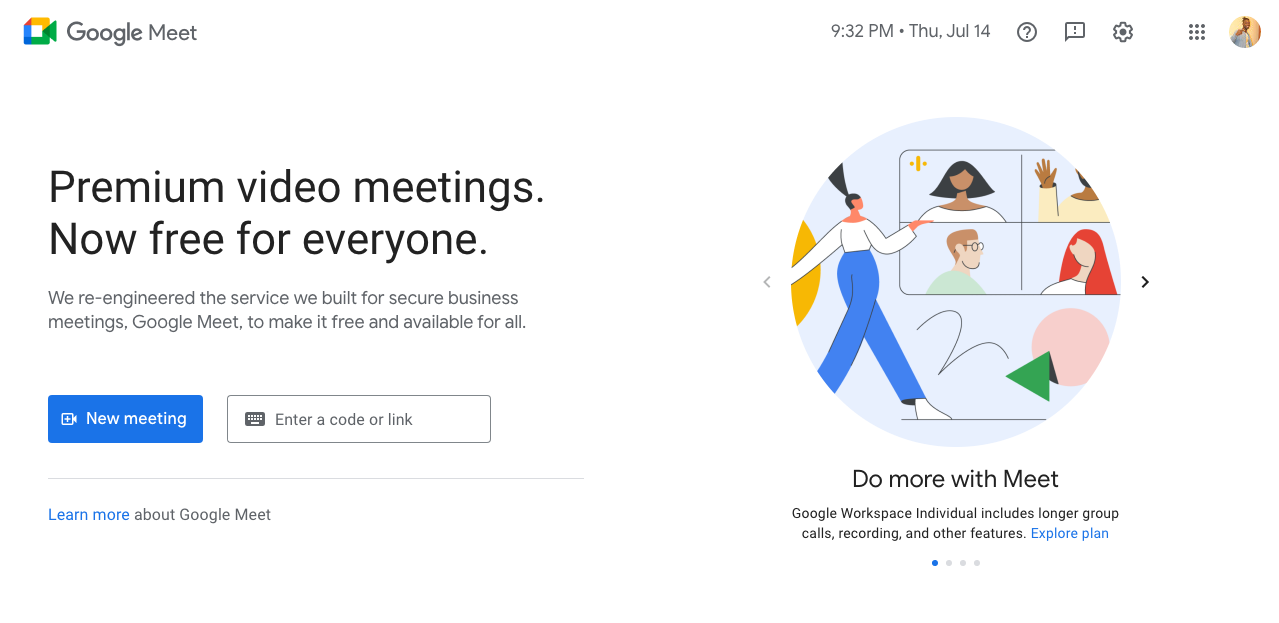
Google Meet is a powerful communication solution that connects you with clients and teams worldwide.
It’s available as a Chrome extension and can be used across all devices, making it convenient and accessible no matter where you are.
One of Google Meet’s standout features is its integration with other Google applications. This allows you to simultaneously present, collaborate, and live stream meetings to up to 100,000 viewers.
It’s a fantastic tool that replaces the old hangouts and brings integrated web conferencing capabilities to your G Suite account.
In addition to its presentation streaming and calendar integration capabilities, Google Meet is also easy to use. He has a range of features that make it an excellent choice for managing meetings.
Whether you collaborate with team members, present to clients, or host a live event, the application works in sync with the other Google applications to streamline your meetings and boost productivity.
Key features of Google Meet.
- Presentation streaming: Live stream your presentations to an audience of up to 100,000 people.
- Meeting preparation tools: Use the Google Meet app to prepare for your meetings by creating agendas and adding meeting notes.
- Calendar Integration: Schedule meetings directly from your Google Calendar.
- Multiparty video meeting: Connect with up to 25 people simultaneously.
- Desktop sharing: Share your screen with others in the meeting to collaborate on a project.
- Meeting initiation: Start or join meetings from your computer, phone, or conference room.
- Participant roles & permissions: Assign participants as presenters or attendees.
- Private chat: Send personal messages to other participants during the meeting.
Google Meet pricing.
Google Meet offers a free plan and 3 premium pricing plans, namely:
- Business Starter: $6 per user per month.
- Business Standard: $12 per user per month.
- Business Plus: $18 per user per month.
Meet is a part of the Google Workspace suite. Every plan includes Gmail, Drive, Meet, Chat, Docs, Sheets, Sites, Forms, and Slides.
8. ZOOM.

Zoom Cloud Meetings is an intelligent communication software that helps you arrange video meetings, conferences, and webinars remotely. It offers easy access and chats across platforms, providing a secure setting with extra encryption and compliance.
With Zoom, you can build collaboration-enabled conference rooms to brainstorm ideas and work on projects, no matter where you are.
Special features include cloud and local recording with transcripts, multi-user annotation capabilities via screen share, and more.
One of Zoom’s standout features is its ability to consolidate communication and help people connect and collaborate better, whether in the boardroom, classroom, operating room, or anywhere else.
Overall, Zoom is a powerful and convenient tool for businesses and individuals to stay connected and collaborate effectively, regardless of their location.
Key features of Zoom.
- Desktop and browser sharing: Zoom lets you share your screen, documents, and applications with others during a meeting and give another participant remote control of your mouse and keyboard.
- On-demand webcasting: You can record your Zoom meetings and make them available for on-demand viewing.
- Auto framing: Automatically zooms and crops your video to keep everyone in view, even if they’re moving around.
- Annotations: You can draw on your screen share to highlight important points or collaborate on a shared document.
- Mobile support: Zoom offers mobile apps for iOS and Android, so you can join or start a meeting from your mobile device.
- Invitation management: Easily manage meeting invitations and track RSVPs.
- Meeting Room Booking: Book meeting rooms directly in Zoom and add them to your calendar invite.
- Discussions and forums: Zoom’s forum feature lets you create a space for threaded discussions before, during, or after your meeting.
Zoom pricing.
Zoom offers a free plan and 3 premium plans priced as below:
- Basic for personal meetings: Free
- Pro for small teams: $14.99/month/host
- Business for small and medium-sized businesses: $19.99/month/host (min 10 hosts)
- Enterprise – for large enterprises: $19.99/month/host (min 100 hosts)
9. Microsoft Teams.
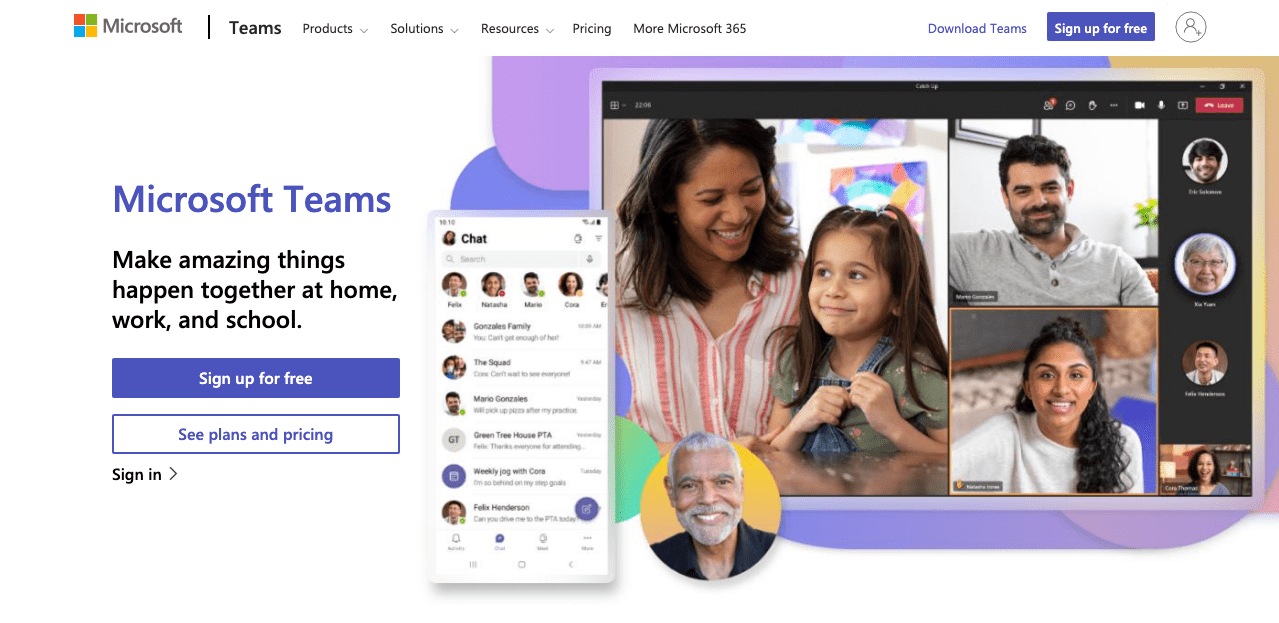
Microsoft Teams is a comprehensive communication software that improves team communication and collaboration. It offers a shared workspace and messaging service for Microsoft Office users, allowing them to conduct conference calls, share files via SharePoint, and join or initiate group chats.
One of the standout features of Microsoft Teams is its availability on iOS, Android, and Windows 10 operating systems, making it convenient and accessible for teams no matter where they are. Teams can make and receive calls directly in the platform, with advanced features like group calling, voicemail, and call transfers.
Microsoft Teams provides an easy way for teams to stay in touch, whether in the same office or remotely.
It offers various features to help teams stay connected and productive, including messaging, calling, and video conferencing, as well as real-time file sharing and collaboration with apps like Word, PowerPoint, and Excel.
Microsoft Teams can share GIFs, stickers, and emojis in one-to-one or group chats, allowing them to share their thoughts and personalities while working together.
Key features of Microsoft Teams.
- Discussion threads: Teams can discuss work-related matters, brainstorm ideas, or stay in touch with what’s going on with other team members.
- Presentation streaming: Share presentations and other documents in real-time and view them together even if you’re not in the same room.
- Surveys and feedback: Conduct surveys and collect feedback from team members to help improve workflows and processes.
- Virtual backgrounds: Change your background during video calls to add a bit of fun or professionalism to your appearance.
- Record & playback ability: Record video calls and meetings for reference or training purposes.
- Commenting/notes: Add comments or notes to shared documents to provide feedback or give direction.
- Mobile screen sharing: Share your screen from your mobile device during meetings for added convenience.
- Backup and recovery: Keep your data safe with backup and recovery features so you can always pick up where you left off.
Microsoft Teams pricing.
Microsoft Teams is now available for free through Microsoft Office 365 subscriptions.
- Premium plans start at $ 4.00 per user monthly and are subject to an annual commitment.
10. MeetingKing.

MeetingKing is a powerful meeting agenda software that helps users structure, record, and follow up on their meetings.
It offers a range of features to help groups work together more effectively, including creating agendas, sharing documents, and assigning tasks.
One of MeetingKing’s standout features is its task-sharing capabilities, which allow all participants to work together on the agenda and provide updates on tasks.
It also offers the ability to export tasks to hundreds of task managers and your calendar, making it easy to keep track of all your meeting tasks and deadlines.
Overall, MeetingKing is a convenient and user-friendly tool that helps teams structure and follow up on meetings more efficiently.
Its collaboration tools make it easy for groups to work together and stay on track, improving productivity and communication.
Key features of MeetingKing.
- Agenda management: Users can quickly create agendas for their meetings. The software includes a variety of templates, so users can easily find the right one for their needs.
- Internal meetings: MeetingKing makes it easy to schedule and manage internal meetings. Users can easily share documents, create agendas, and assign tasks with the software.
- Meeting management: This service offers various meeting management tools to help users structure and follow up on their meetings, including the ability to share documents, create agendas, and assign tasks.
- Task management: Users can easily create and manage tasks with various templates to find the right one for their needs.
- Video library: The software includes a video library with various videos on meeting management topics.
- Google Calendar integration: Users can easily integrate MeetingKing with their Google Calendar.
MeetingKing pricing.
MeetingKing offers a free trial on all its 4 premium tiers with pricing based on per user per month:
- Pro single user: $9.95 per month.
- Pro small for 5 users: $39.95 per month.
- Pro medium for 10 users: $64.95 per month.
- Pro large for 25 users: 124.95 per month.
All Meeting participants can contribute to any meeting with a free account.
11. HubSpot Free meeting scheduler.
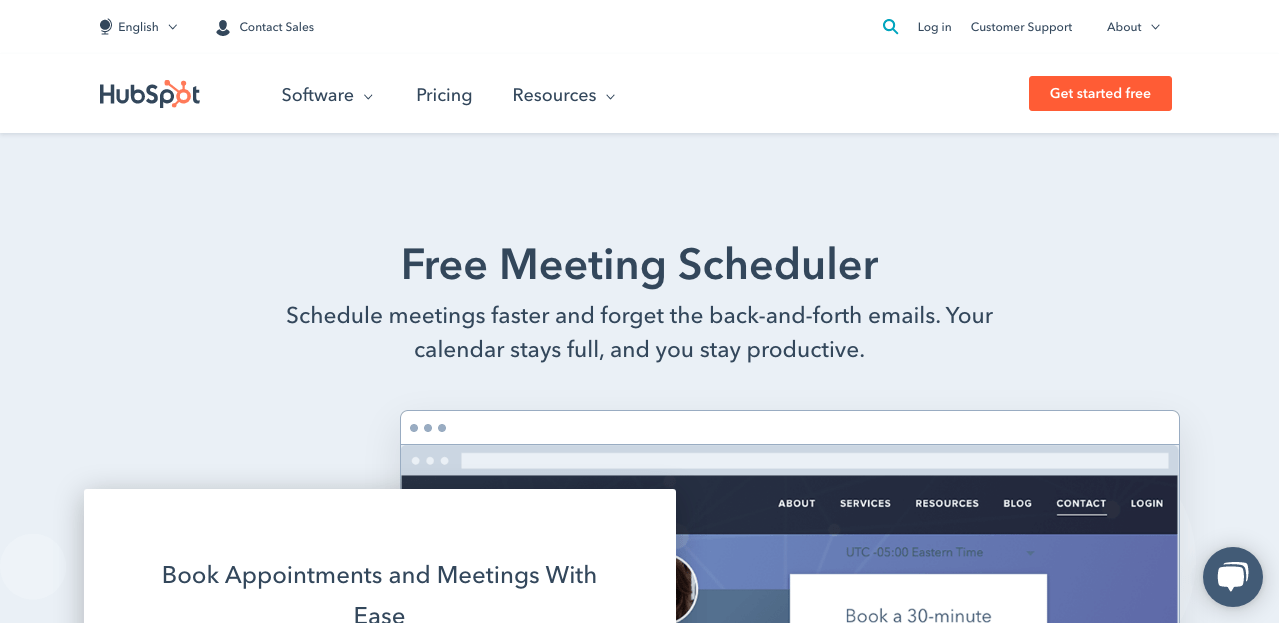
HubSpot’s Meeting Scheduler is a convenient and hassle-free meeting scheduling software that allows you to book appointments with prospects and customers easily.
It automatically syncs with Google or Office 365 calendars, making it easy for customers to find times that work for them.
The Meeting Scheduler also allows companies to add it to their website or emails, making it easy for prospects to book appointments with just a few clicks.
Additionally, it offers a range of features to help teams manage their meeting schedules and keep track of their meeting times.
One of the standout features of HubSpot’s Meeting Scheduler is the ability for prospects to automatically book a meeting with you or multiple people in your company.
You can use group meeting links or a round-robin meeting line to allow prospects to schedule time with multiple people. You can even embed your calendar on your website (no coding required) to generate more meetings and leads.
Key features of HubSpot’s Meeting Scheduler.
- Sync with HubSpot CRM, Microsoft 365, and Google Calendar: Easily track your meeting times and ensure that existing and prospective customers can always find a time that works.
- Integration with project management tools: The meeting scheduler is integrated with HubSpot’s project management tools, making it easy for teams to manage their meeting schedules.
- Embeddable calendar widget: Add the meeting scheduler to your website or email signature so prospects can easily book appointments.
- Automatic time zones: Automatically adjusts to the correct time zone, so you don’t have to worry about planning meetings in different time zones.
- Direct links: Offers direct links to your meetings so you can share them with prospects or customers easily.
- Customer surveys: You can collect customer feedback after meetings to improve your meeting management process.
- Contacts database: Keeps track of your contacts so you can add them to your meeting invitations easily.
- Create and edit meetings: This allows you to easily create and edit your meeting times and details.
HubSpot meetings pricing:
- The HubSpot meeting scheduler is free to use, but you can upgrade to the paid plan for $25 per month.
Related article: 7 Best HubSpot Competitors
What Is Meeting Management Software?
Meeting management software helps organizations plan, schedule, and conduct meetings more efficiently. It can be used to schedule meetings, manage agendas, track attendees, record minutes, and follow up on action items.
Meeting management software often includes calendar integration, document sharing, task management, and real-time collaboration tools. It may also have video conferencing capabilities and support for virtual meetings.
Meeting management software aims to help organizations streamline their meeting processes and improve productivity. It can be used by businesses of all sizes and in various industries, including finance, healthcare, education, and technology.
How To Choose The Best Meeting Management Software.
Now, let’s walk you through some of the critical factors to consider when choosing meeting software, including:
Ease Of Use
Ease of use is an essential factor to consider when choosing meeting management software, as it can impact the productivity of your meetings. The software should have a user-friendly interface that allows you to start and join meetings, share your screen, and collaborate. This helps minimize disruptions and ensure that sessions run smoothly.
Analytics
Meeting analytics can provide valuable insights about your meetings, such as who attended and when, how long the meeting lasted, and what topics were discussed.
This data can help you improve the quality of your meetings and ensure their productivity. For example, if you notice that meetings frequently run over time, consider adjusting your agenda or setting stricter time limits to help keep meetings on track.
Security And Access
The software should have robust security features to protect your meetings from being hacked or disrupted. It should also allow you to control who can join your meetings and when they can join. This helps ensure that only authorized individuals can access your discussions and that your meetings are kept private.
Meeting Check-Ins
Meeting check-ins can ensure that all of your attendees are present and accounted for. Some meeting management software includes features that allow you to take attendance or check in with attendees to confirm their presence. This can be especially useful for virtual meetings, where tracking who is present may be more challenging.
Taking attendance or checking in with attendees can help ensure that meetings are productive and that all participants can fully engage in the discussion.
Supports Multiple Media Types
Supporting multiple media types is essential for meeting management software because it allows attendees to participate in the meeting in the best way.
For example, if some attendees prefer to communicate via audio while others prefer video or text chat, the software should be able to accommodate all of these methods.
Integrations
Integrations with other tools, such as calendars, email, and chat, are another critical feature to look for in meeting management software. Integrating these tools allows the software to streamline the meeting process and eliminate the need to switch between different applications. For example, if the software integrates with your calendar, you can easily schedule and manage meetings directly from your calendar.
Steps For Effective Meeting Management.
Meetings are necessary for the workplace but can often be inefficient and unproductive.
If you want to ensure that your meetings are as effective as possible, follow these simple steps.
Step #1. Define The Purpose Of The Meeting
Before organizing a meeting, it is essential to clearly understand its purpose. This helps ensure that the meeting is focused and that the time spent is productive.
Without a clear purpose, the meeting may wander off-topic or be unnecessarily long. By defining the purpose, you can also determine the necessary attendees and the type of meeting needed (e.g., a presentation, discussion, or decision-making). This helps ensure that the right people are present and that the meeting format is appropriate for achieving the desired outcome.
Step #2. Set A Specific Agenda And Share It With Attendees
A specific meeting agenda helps ensure all attendees know what to expect and can come prepared to participate.
It also helps to keep the meeting focused and on track, as it provides a clear outline of the topics that need to be discussed.
Sharing the agenda with attendees in advance also allows them to review the material and come prepared with any questions or comments they may have. This can make the meeting more efficient and productive, as attendees can contribute meaningfully and stay engaged throughout the discussion.
Step #3. Choose A Convenient Time And Location For All Participants
It’s important to choose a convenient time for all participants because if some people can’t attend at the scheduled time, it can impact the meeting’s productivity.
If the meeting is scheduled during peak hours, it might be harder for people to focus due to distractions. It’s also important to consider the location of the meeting and make sure it is convenient for all attendees.
If the location is not easily accessible, it may discourage some people from attending.
Step #4. Appoint A Skilled Facilitator To Keep The Meeting On Track
A facilitator plays a crucial role in ensuring that the meeting stays on track and productive. They can do this in several ways.
They can help with time management by monitoring the clock and ensuring the meeting stays within the allotted time frame. This helps to ensure that all agenda items are covered and that there is time for discussion and Q&A.
Second, the facilitator can help keep discussions organized by maintaining a clear structure and ensuring that all attendees can speak. The facilitator can also ensure that all attendees have a chance to voice their opinions and ideas.
Step #5. Encourage Active Participation From All Attendees
Encouraging active participation from all attendees is important because it helps ensure everyone’s ideas and opinions are heard and considered. It also helps create a sense of collaboration and ownership among the team, which can lead to better decision-making and more buy-in for the meeting’s outcomes.
To encourage active participation, the facilitator can ask for input and feedback from all attendees, create an inclusive and welcoming environment, and allow for open and honest discussion. It’s also essential to ensure that all attendees feel comfortable speaking up and that their ideas are valued.
Step #6. Take Breaks As Needed And End The Meeting On Time
Taking breaks during a long meeting can help to rejuvenate attendees and keep them focused. It’s important to schedule these breaks at appropriate times, such as after a particularly intense or long discussion.
It’s also vital to ensure the meeting ends on time so attendees can return to their other tasks and responsibilities.
Step #7. Follow-Up With Participants After The Meeting
Following up helps to ensure that meeting goals are met and tasks are completed on time. By following up with participants, you can confirm that everyone understands their responsibilities and has the necessary resources to complete their tasks.
Additionally, following up helps to hold people accountable for their commitments and ensures that the meeting is productive and a good use of time.
Meeting Management Software FAQ
What is the best free meeting management software?
There are a few great options for free meeting management software.
- Calendly
- ClickUp
- Zoom
- Slack
Calendly is an excellent option for scheduling meetings with clients or colleagues. It integrates with your calendar, so you can easily find meeting times that work for everyone.
ClickUp is a great option to track meeting minutes and action items. It’s also super user-friendly and has many great features, like adding meeting notes and setting follow-up reminders.
Zoom is an excellent choice for holding video conferences or webinars. Its audio and video quality are crystal clear, and you can record your meetings to review them later.
Slack is a great option if you need to have real-time chat conversations with colleagues or clients. You can easily share files and documents, and there’s also a handy search feature for finding old messages.
What is the best enterprise meeting management software?
- ClickUp,
- Calendly,
- Google Meet, and
- Zoom
ClickUp is an excellent option for features like meeting minutes, transcriptions, and recordings.
Calendly is an excellent choice if you need features like meeting scheduling, meeting reminders, and meeting invitations.
Google Meet is an excellent choice if you need video conferencing and screen-sharing capabilities.
Zoom is an excellent choice if you need webinars and group chat features. All these software options are excellent choices for enterprise meeting management software.
Best meeting management software: Wrap Up.
Well, there you have it! The 11 best meeting management software options for your team’s needs.
Whether you’re looking for a solution with top-notch security, integrations with your favourite tools, or the ability to host virtual events with thousands of attendees, one of these options is the perfect fit.
Just remember to clearly define the purpose of your meetings, set a specific agenda, choose a convenient time and location, appoint a skilled facilitator, encourage active participation, take breaks as needed, and follow up with participants to ensure action items are completed.
With the right software and a little organization, you’ll be well on your way to hosting productive, efficient, and enjoyable meetings (gasp!). Happy conferencing!
Further reading on Fontish.com. If you want to start selling online, this article on How to Sell Digital Products Using WordPress will help.


